formerly eScholarship Editions


|
|
|
|
Your search for
'Music' in subject
found 59 book(s). | Modify Search | Displaying 1 - 20 of 59 book(s) | |
| 1. | 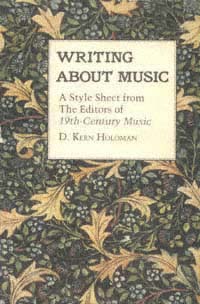 | Title: Writing about music: a style sheet from the editors of 19th-century music Author: Holoman, D. Kern 1947- Published: University of California Press, 1988 Subjects: Music | Music Publisher's Description: How do you spell Rachmaninov?Where do you place the hyphen in Hofmannsthal if it breaks across two lines? Is it premiere or première? The answers and much more can be found in a new, essential resource for authors, students, editors, concert producers - anyone who deals with music in print. An expanded version of the style sheet for the well-known journal 19th-Century Music , this small volume covers some of the thorniest issues of musical discourse: how to go about describing musical works and procedures in prose, the rules for citations in notes and bibliography, and proper preparation of such materials as musical examples, tables, and illustrations. One section discusses program notes, another explains the requirements of submitting manuscripts written on a word processor. An appendix lists common problem words. [brief] Similar Items |
| 2. | 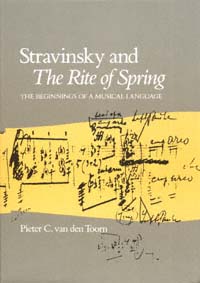 | Title: Stravinsky and the Rite of spring: the beginnings of a musical language Author: Van den Toorn, Pieter C 1938- Published: University of California Press, 1987 Subjects: Music | Composers Similar Items |
| 3. | 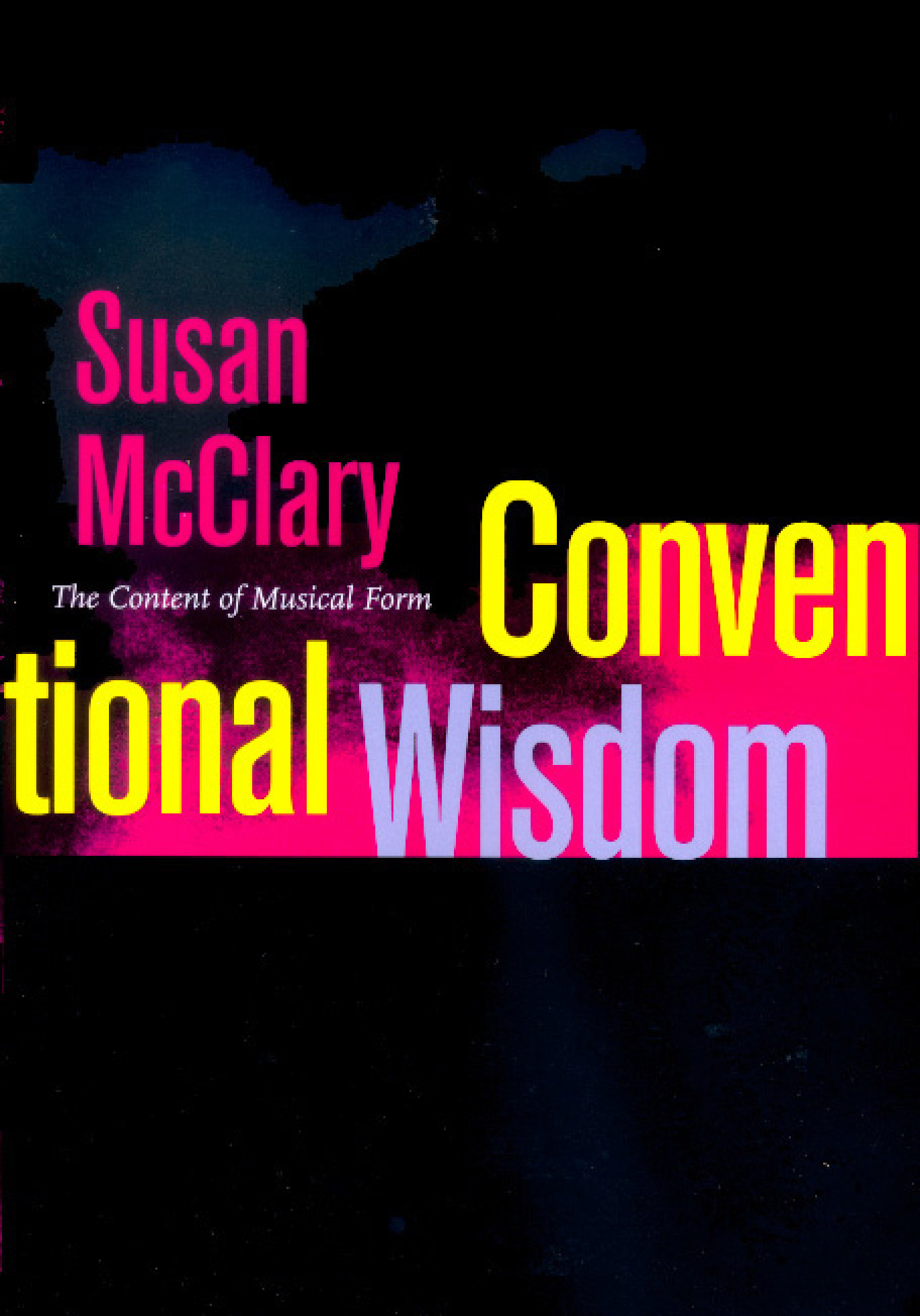 | Title: Conventional wisdom: the content of musical form Author: McClary, Susan Published: University of California Press, 2000 Subjects: Music | Musicology Publisher's Description: With her usual combination of erudition, innovation, and spirited prose, Susan McClary reexamines the concept of musical convention in this fast-moving and refreshingly accessible book. Exploring the ways that shared musical practices transmit social knowledge, Conventional Wisdom offers an account of our own cultural moment in terms of two dominant traditions: tonality and blues.McClary looks at musical history from new and unexpected angles and moves easily across a broad range of repertoires--the blues, eighteenth-century tonal music, late Beethoven, and rap. As one of the most influential trailblazers in contemporary musical understanding, McClary once again moves beyond the borders of the "purely musical" into the larger world of history and society, and beyond the idea of a socially stratified core canon toward a musical pluralism. Those who know McClary only as a feminist writer will discover her many other sides, but not at the expense of gender issues, which are smoothly integrated into the general argument. In considering the need for a different way of telling the story of Western music, Conventional Wisdom bravely tackles big issues concerning classical, popular, and postmodern repertoires and their relations to the broader musical worlds that create and enjoy them. [brief] Similar Items |
| 4. |  | Title: The ultimate art: essays around and about opera Author: Littlejohn, David 1937- Published: University of California Press, 1992 Subjects: Music | Opera Publisher's Description: Anyone who cares about opera will find The Ultimate Art a thoroughly engaging book. David Littlejohn's essays are exciting, provocative, sometimes even outrageous. They reflect his deep love of opera - that exotic, extravagant, and perpetually popular hybrid performing art form - and his fascination with the many worlds from which it sprang.From its seventeenth-century beginnings, opera has been decried by its detractors for its elitism, its artifice, its absurd costliness, and its social irrelevance. But Littlejohn makes us see that opera embraces an extraordinary amount of intense human emotion and experience, Western culture, and individual psychology. It is also the most complex, challenging, and demanding form of public performance ever developed - at its most spectacular it pulls together in one evening a play, a concert, a ballet, and a pageant, not to mention an exhibition of painting and sculpture. Every opera is a veritable piece of cultural history.The book begins with "The Difference Is They Sing," a potentially controversial essay on the nature of opera and its place in modern culture. From there Littlejohn goes on to consider everything from "Sex and Religion in French Opera" to "What Peter Sellars Did to Mozart." He tells us about every major staging of Wagner's Ring cycle since 1876, the troubled fate (in legend, history, and opera) of the city of Nuremberg, and the volatile collaboration of Richard Strauss and Hugo von Hofmannsthal.Littlejohn presents these and many other fascinating moments in the history of opera with conviction and flair. By the end of the book the reader may very well be persuaded that opera is indeed the ultimate art. [brief] Similar Items |
| 5. | 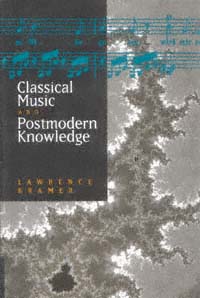 | Title: Classical music and postmodern knowledge Author: Kramer, Lawrence 1946- Published: University of California Press, 1995 Subjects: Music | Musicology Publisher's Description: A leading cultural theorist and musicologist opens up new possibilities for understanding mainstream Western art music - the "classical" music composed between the eighteenth and early twentieth centuries that is, for many, losing both its prestige and its appeal. When this music is regarded esoterically, removed from real-world interests, it increasingly sounds more evasive than transcendent. Now Lawrence Kramer shows how classical music can take on new meaning and new life when approached from postmodernist standpoints.Kramer draws out the musical implications of contemporary efforts to understand reason, language, and subjectivity in relation to concrete human activities rather than to universal principles. Extending the rethinking of musical expression begun in his earlier Music as Cultural Practice , he regards music not only as an object that invites aesthetic reception but also as an activity that vitally shapes the personal, social, and cultural identities of its listeners.In language accessible to nonspecialists but informative to specialists, Kramer provides an original account of the postmodernist ethos, explains its relationship to music, and explores that relationship in a series of case studies ranging from Haydn and Mendelssohn to Ives and Ravel. [brief] Similar Items |
| 6. | 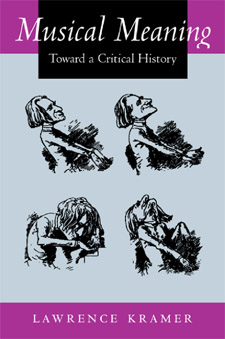 | Title: Musical meaning: toward a critical history Author: Kramer, Lawrence 1946- Published: University of California Press, 2001 Subjects: Music | Musicology Publisher's Description: Lawrence Kramer has been a pivotal figure in the development of the controversial new musicology, integrating the study of music with social and cultural issues. This accessible and eloquently written book continues and deepens the trajectory of Kramer's thinking as it boldly argues that humanistic, not just technical, meaning is a basic force in music history and an indispensable factor in how, where, and when music is heard. Kramer draws on a broad range of music and theory to show that the problem of musical meaning is not just an intellectual puzzle, but a musical phenomenon in its own right. How have romantic narratives involving Beethoven's "Moonlight" Sonata affected how we hear this famous piece, and what do they reveal about its music? How does John Coltrane's African American identity affect the way we hear him perform a relatively "white" pop standard like "My Favorite Things"? Why does music requiring great virtuosity have different cultural meanings than music that is not particularly virtuosic? Focusing on the classical repertoire from Beethoven to Shostakovich and also discussing jazz, popular music, and film and television music, Musical Meaning uncovers the historical importance of asking about meaning in the lived experience of musical works, styles, and performances. Kramer's writing, clear and full of memorable formulations, demonstrates that thinking about music can become a vital means of thinking about general questions of meaning, subjectivity, and value. In addition to providing theoretical advances and insights on particular pieces and repertoires, Musical Meaning will be provocative reading for those interested in issues of identity, gender, and cultural theory. This book includes a CD of Kramer's own composition, Revenants: 32 Variations in C Minor, which he discusses in his final chapter. [brief] Similar Items |
| 7. | 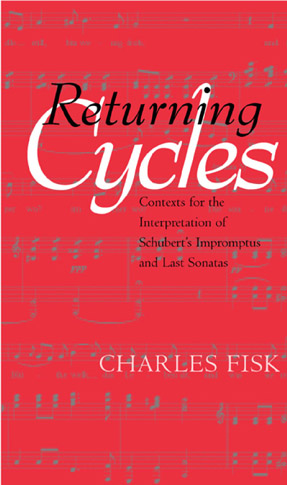 | Title: Returning cycles: contexts for the interpretation of Schubert's impromptus and last sonatas Author: Fisk, Charles Published: University of California Press, 2001 Subjects: Music | Musicology | Composers Publisher's Description: This compelling investigation of the later music of Franz Schubert explores the rich terrain of Schubert's impromptus and last piano sonatas. Drawing on the relationships between these pieces and Schubert's Winterreise song cycle, his earlier "Der Wanderer," the closely related "Unfinished" Symphony, and his story of exile and homecoming, "My Dream," Charles Fisk explains how Schubert's view of his own life may well have shaped his music in the years shortly before his death. Fisk's intimate portrayal of Schubert is based on evidence from the composer's own hand, both verbal (song texts and his written words) and musical (vocal and instrumental). Noting extraordinary aspects of tonality, structure, and gestural content, Fisk argues that through his music Schubert sought to alleviate his apparent sense of exile and his anticipation of early death. Fisk supports this view through close analyses of the cyclic connections within and between the works he explores, finding in them complex musical narratives that attempt to come to terms with mortality, alienation, hope, and desire. Fisk's knowledge of Schubert's life and music, together with his astute and imaginative attention to musical detail, helps him achieve one of the most difficult goals in music criticism: to capture and verbalize the human content of instrumental music. [brief] Similar Items |
| 8. | 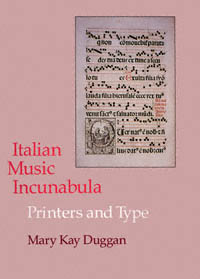 | Title: Italian music incunabula: printers and type Author: Duggan, Mary Kay Conyers Published: University of California Press, 1992 Subjects: Music | Musicology | Medieval Studies Publisher's Description: Musical notation presented unusual challenges to the new craft of printing in the fifteenth century. Its demands were so difficult that the first impression of music from metal type was not made until a full twenty years after the first printed alphabetic texts. By the end of the century dozens of such fonts had appeared throughout Europe. The books that resulted were often impressive volumes of folio or large-folio size, printed in two colors, with woodcut illustrations.Mary Kay Duggan focuses on the technological processes developed in Italy to print music books. She begins by tracing the history and analyzing the techniques of casting and setting type and staves. She then identifies, classifies, and examines thirty-eight specific types. Finally, the author has compiled a descriptive bibliography of Italian music incunabula, including books containing either printed music or blank spaces for the insertion of manuscript music. Italian Music Incunabula marks a major advance in the study of the paleotypography of music. It greatly enhances our understanding of the impact of the printing press on music and the importance of music books in the work of early printers. Its meticulous bibliography of over 150 incunabula, concordances, and indices will make it the standard reference work for many years to come. [brief] Similar Items |
| 9. | 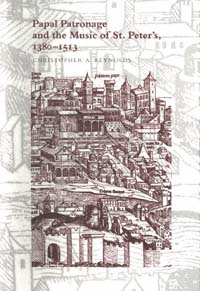 | Title: Papal patronage and the music of St. Peter's, 1380-1513 Author: Reynolds, Christopher A Published: University of California Press, 1996 Subjects: Music | Musicology | European History Publisher's Description: A new picture of music at the basilica of St. Peter's in the fifteenth century emerges in Christopher A. Reynolds's fascinating chronicle of this rich period of Italian musical history. Reynolds examines archival documents, musical styles, and issues of artistic patronage and cultural context in a fertile consideration of the ways historical and musical currents affected each other.This work is both a historical account of performers and composers and an examination of how their music revealed their cultural values and educational backgrounds. Reynolds analyzes several anonymous masses copied at St. Peter's, proposing attributions that have biographical implications for the composers. Taken together, the archival records and the music sung at St. Peter's reveal a much clearer picture of musical life at the basilica than either source would alone. The contents of the St. Peter's choirbook help document musical life as surely as that musical life - insofar as it can be reconstructed from the archives - illumines the choirbook. [brief] Similar Items |
| 10. | 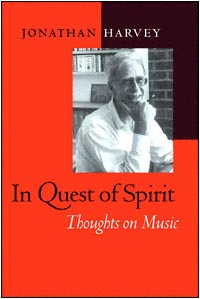 | Title: In quest of spirit: thoughts on music Author: Harvey, Jonathan 1939- Published: University of California Press, 1999 Subjects: Music | Composers | Contemporary Music | Religion Publisher's Description: The interests of the British composer Jonathan Harvey are wide and varied, embracing Christianity, Buddhism, eastern and western philosophy, aesthetics, science, and mysticism. All affect his musical thinking and are a part of this unusual and personal book, which is accompanied by a compact disc featuring works discussed by the author.Harvey explores aspects of music that he connects with spirituality: self-identity, ambiguity, unity, stasis, and silence. In the course of his explorations he offers corroborating statements about music and spirituality from sources ranging from Nietzsche to Oliver Sacks. The book and CD include samples of his own music as well as compositions by Mozart, Scriabin, Stockhausen, and others that help to illustrate the profoundness of what Harvey deems "the good listening experience."For Harvey, composing is his way of trying to live a life "skillfully" in the Buddhist sense. In Quest of Spirit is a window into his creative world and provides a sense of what music can mean at the moment of its inception. [brief] Similar Items |
| 11. | 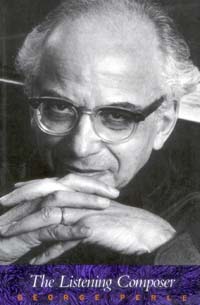 | Title: The listening composer Author: Perle, George 1915- Published: University of California Press, 1990 Subjects: Music | Contemporary Music | Composers Publisher's Description: George Perle takes us into the composer's workshop as he reevaluates what we call "twentieth-century music" - a term used to refer to new or modern or contemporary music that represents a radical break from the tonal tradition, or "common practice," of the preceding three centuries. He proposes that this music, in the course of breaking with the tonal tradition, presents coherent and definable elements of a new tradition. In spite of the disparity in their styles, idioms, and compositional methods, he argues, what unites Scriabin, Stravinsky, Bartók, and the Viennese circle (Schoenberg, Berg, and Webern) is more important than what separates them.If we are to understand the connections among these mainstream composers, we also have to understand their connections with the past. Through an extraordinarily comprehensive analysis of a single piece by Varèse, Density 21.5 for unaccompanied flute, Perle shows how these composers refer not only to their contemporaries but also to Wagner, Debussy, and Beethoven.Perle isolates the years 1909-10 as the moment of revolutionary transformation in the foundational premises of our musical language. He asks: What are the implications of this revolution, not only for the composer, but also for the listener? What are the consequences for the theory and teaching of music today? In his highly original answers, Perle relates the role of intuition in the listening experience to its role in the compositional process.Perle asserts that the post-Schoenbergian serialists have preoccupied themselves with secondary and superficial aspects of Schoenberg's twelve-tone method that have led it to a dead end but he also exposes the speciousness of current alternatives such as chance music, minimalism, and the so-called return to tonality. He offers a new and more comprehensive definition of "twelve-tone music" and firmly rejects the notion that accessibility to the new music is reserved for a special class of elite listeners. [brief] Similar Items |
| 12. | 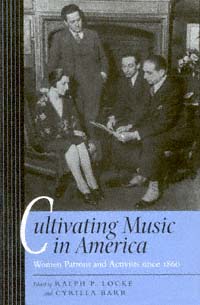 | Title: Cultivating music in America: women patrons and activists since 1860 Author: Locke, Ralph P Published: University of California Press, 1997 Subjects: Music | Women's Studies | Popular Culture Publisher's Description: This wide-ranging collection brings together leading authorities on the social history of American art music to reveal the indispensable contribution that women have made to American musical life. Some chapters discuss collective endeavors, such as music clubs, Wagnerites, supporters of "modern music" in the 1920s, and activists in African American communities, while others focus on the work of a single, strikingly individual patron such as Isabella Stewart Gardner or Elizabeth Sprague Coolidge. Primary sources such as private letters and autobiographies are utilized, and documentary vignettes scattered throughout the book bring to life important events and reminiscences. Among these are an interview with Betty Freeman, noted patron of avant-garde music, and advice from Mildred Bliss to Nadia Boulanger. Extensive opening and closing chapters provide conceptual and factual background on music in America and draw out the larger implications of women's patronage in the past, present, and future. [brief] Similar Items |
| 13. | 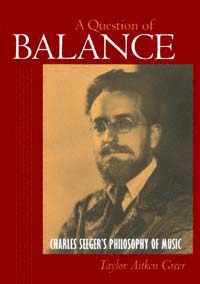 | Title: A question of balance: Charles Seeger's philosophy of music Author: Greer, Taylor Aitken 1955- Published: University of California Press, 1998 Subjects: Music | Ethnomusicology | Musicology | Composers Publisher's Description: One of this century's most influential musical intellects takes center stage in Taylor Greer's meticulously wrought study of Charles Seeger (1886-1979). Seeger left an indelible mark in the fields of musicology, music criticism, ethnomusicology, and avant-garde musical composition, but until now there has been no extended appreciation and critique of Seeger's work as a whole, nor has an accessible guide to his texts been available.Exploring the entire corpus of Charles Seeger's writing, A Question of Balance highlights the work of those persons who most influenced him, especially Henri Bergson, Bertrand Russell, and Ralph Perry. Invited to inaugurate the music department at the University of California's Berkeley campus in 1912, Seeger became keenly aware of his deficiencies in general education and put himself on a rigorous regimen of intellectual development that included studying history, anthropology, political theory, and philosophy. For the remainder of his life his ideas about music heavily influenced the development of ethnomusicology and systematic musicology.Charles Seeger is perhaps best known as the father of the folk singers Pete, Mike, and Peggy Seeger and as the husband of the innovative American composer Ruth Crawford. This book makes clear that Seeger was an extremely important thinker and educator in his own right. Seeger's intellectual curiosity was as eclectic as it was enthusiastic, and Greer skillfully weaves together the connections Seeger made between music, the humanities, and the sciences. The result is a luminous tapestry depicting Seeger's ideal schemes of musicology. At the same time it reflects the turbulence and vitality in American musical life during the early decades of the century. [brief] Similar Items |
| 14. | 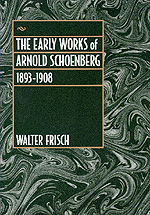 | Title: The early works of Arnold Schoenberg, 1893-1908 Author: Frisch, Walter Published: University of California Press, 1997 Subjects: Music | Composers | Contemporary Music | Musicology Publisher's Description: Here is the first full-scale account of Schoenberg's early tonal works, a rich repertory that music historians have tended to neglect or view as transitional to a mature atonal style.Between 1893 and 1908, Schoenberg created many genuine masterworks in the genres of Lieder, chamber music, and symphonic music. This book includes detailed critical analyses of such widely admired and performed compositions as Verklärte Nacht , Gurrelieder , and the First Chamber Symphony, as well as discussions of little-known but important songs and instrumental works from the earlier years.Drawing on original manuscript sources, on Schoenberg's musical environment, on a range of analytical methods, and on Schoenberg's own theories, Frisch traces the development of technique and aesthetic across this critical fifteen-year period of the composer's career. [brief] Similar Items |
| 15. | 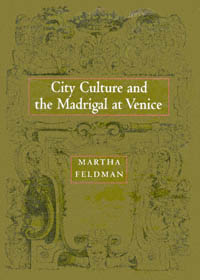 | Title: City culture and the madrigal at Venice Author: Feldman, Martha Published: University of California Press, 1995 Subjects: Music | Musicology | European History Publisher's Description: Martha Feldman's exploration of sixteenth-century Venetian madrigals centers on the importance to the Venetians of Ciceronian rhetorical norms, which emphasized decorum through adherence to distinct stylistic levels. She shows that Venice easily adapted these norms to its long-standing mythologies of equilibrium, justice, peace, and good judgment. Feldman explains how Venetian literary theorists conceived variety as a device for tempering linguistic extremes and thereby maintaining moderation. She further shows how the complexity of sacred polyphony was adapted by Venetian music theorists and composers to achieve similar ends.At the same time, Feldman unsettles the kinds of simplistic alignments between the collectivity of the state and its artistic production that have marked many historical studies of the arts. Her rich social history enables a more intricate dialectics among sociopolitical formations; the roles of individual printers, academists, merchants, and others; and the works of composers and poets. City Culture offers a new model for situating aesthetic products in a specific time and place, one that sees expressive objects not simply against a cultural backdrop but within an integrated complex of cultural forms and discursive practices. [brief] Similar Items |
| 16. | 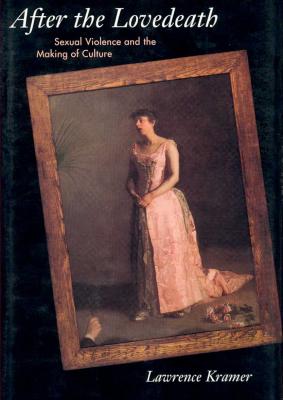 | Title: After the lovedeath: sexual violence and the making of culture Author: Kramer, Lawrence 1946- Published: University of California Press, 1997 Subjects: Gender Studies | Literature | Music Publisher's Description: This elegantly written book is a bold attempt to reinterpret the nature of sexual violence and to imagine the possibility of overcoming it. Lawrence Kramer traces today's sexual identities to their nineteenth-century sources, drawing on the music, literature, and thought of the period to show how normal identity both promotes and rationalizes violence against women.To make his case, Kramer uses operatic lovedeaths, Beethoven's "Kreutzer Sonata" and the Tolstoy novella named after it; the writings of Walt Whitman and Alfred Lord Tennyson, psychoanalysis, and the logic of dreams. In formal and informal reflections, he explores the self-contradictions of masculinity, the shifting alignments of femininity, authority, and desire, and the interdependency of hetero- and homosexuality. At the same time, he imagines alternatives that could allow gender to be freed from the existing system of polarities that inevitably promote sexual violence.Kramer's writing avoids the conventional dress of intellectual authority and moves between music and literature in a style that is both intimate and effective. He combines informed scholarship with candid personal utterance and makes clear what is at stake in this crucial debate. After the Lovedeath will have a profound impact on anyone interested in new ways to think about gender. [brief] Similar Items |
| 17. | 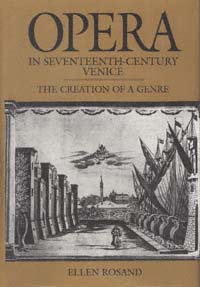 | Title: Opera in seventeenth-century Venice: the creation of a genre Author: Rosand, Ellen Published: University of California Press, 1990 Subjects: Music | Musicology | Opera | European History Publisher's Description: Ellen Rosand shows how opera, born of courtly entertainment, took root in the special social and economic environment of seventeenth-century Venice and there developed the stylistic and aesthetic characteristics we recognize as opera today. With ninety-one music examples, most of them complete pieces nowhere else in print, and enlivened by twenty-eight illustrations, this landmark study will be essential for all students of opera, amateur and professional, and for students of European cultural history in general.Because opera was new in the seventeenth century, the composers (most notably Monteverdi and Cavalli), librettists, impresarios, singers, and designers were especially aware of dealing with aesthetic issues as they worked. Rosand examines critically for the first time the voluminous literary and musical documentation left by the Venetian makers of opera. She determines how these pioneers viewed their art and explains the mechanics of the proliferation of opera, within only four decades, to stages across Europe. Rosand isolates two features of particular importance to this proliferation: the emergence of conventions - musical, dramatic, practical - that facilitated replication; and the acute self-consciousness of the creators who, in their scores, librettos, letters, and other documents, have left us a running commentary on the origins of a genre. [brief] Similar Items |
| 18. | 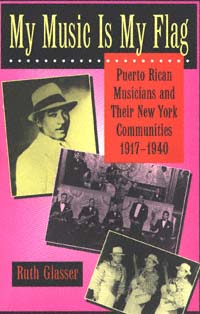 | Title: My music is my flag: Puerto Rican musicians and their New York communities, 1917-1940 Author: Glasser, Ruth Published: University of California Press, 1995 Subjects: History | American Studies | Music Publisher's Description: Puerto Rican music in New York is given center stage in Ruth Glasser's original and lucid study. Exploring the relationship between the social history and forms of cultural expression of Puerto Ricans, she focuses on the years between the two world wars. Her material integrates the experiences of the mostly working-class Puerto Rican musicians who struggled to make a living during this period with those of their compatriots and the other ethnic groups with whom they shared the cultural landscape.Through recorded songs and live performances, Puerto Rican musicians were important representatives for the national consciousness of their compatriots on both sides of the ocean. Yet they also played with African-American and white jazz bands, Filipino or Italian-American orchestras, and with other Latinos. Glasser provides an understanding of the way musical subcultures could exist side by side or even as a part of the mainstream, and she demonstrates the complexities of cultural nationalism and cultural authenticity within the very practical realm of commercial music.Illuminating a neglected epoch of Puerto Rican life in America, Glasser shows how ethnic groups settling in the United States had choices that extended beyond either maintenance of their homeland traditions or assimilation into the dominant culture. Her knowledge of musical styles and performance enriches her analysis, and a discography offers a helpful addition to the text. [brief] Similar Items |
| 19. | 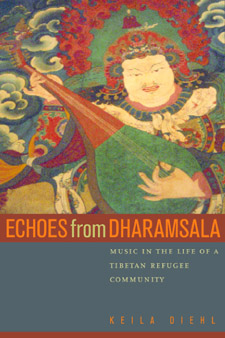 | Title: Echoes from Dharamsala: music in the life of a Tibetan refugee community Author: Diehl, Keila Published: University of California Press, 2002 Subjects: Music | Ethnomusicology | Tibet | Southeast Asia | Cultural Anthropology Publisher's Description: In Echoes from Dharamsala, Keila Diehl uses music to understand the experiences of Tibetans living in Dharamsala, a town in the Indian Himalayas that for more than forty years has been home to Tibet's government-in-exile. The Dalai Lama's presence lends Dharamsala's Tibetans a feeling of being "in place," but at the same time they have physically and psychologically constructed Dharamsala as "not Tibet," as a temporary resting place to which many are unable or unwilling to become attached. Not surprisingly, this community struggles with notions of home, displacement, ethnic identity, and assimilation. Diehl's ethnography explores the contradictory realities of cultural homogenization, hybridity, and concern about ethnic purity as they are negotiated in the everyday lives of individuals. In this way, she complicates explanations of culture change provided by the popular idea of "global flow." Diehl's accessible, absorbing narrative argues that the exiles' focus on cultural preservation, while crucial, has contributed to the development of essentialist ideas of what is truly "Tibetan." As a result, "foreign" or "modern" practices that have gained deep relevance for Tibetan refugees have been devalued. Diehl scrutinizes this tension in her discussion of the refugees' enthusiasm for songs from blockbuster Hindi films, the popularity of Western rock and roll among Tibetan youth, and the emergence of a new genre of modern Tibetan music. Diehl's insight into the soundscape of Dharamsala is enriched by her own experiences as the keyboard player for a Tibetan refugee rock group called the Yak Band. Her groundbreaking study reveals the importance of music as a site where official and personal, old and new representations of Tibetan culture meet and where different notions of "Tibetan-ness" are being imagined, performed, and debated. [brief] Similar Items |
| 20. | 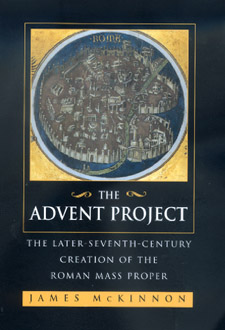 | Title: The Advent project: the later-seventh-century creation of the Roman Mass proper Author: McKinnon, James W 1932- Published: University of California Press, 2000 Subjects: Music | Musicology | Medieval Studies | Classical Religions | Christianity Publisher's Description: In his final accomplishment of an extraordinarily distinguished career, James W. McKinnon considers the musical practices of the early Church in this incisive examination of the history of Christian chant from the years a.d. 200 to 800. The result is an important book that is certain to have a long- . . . [more] Similar Items |